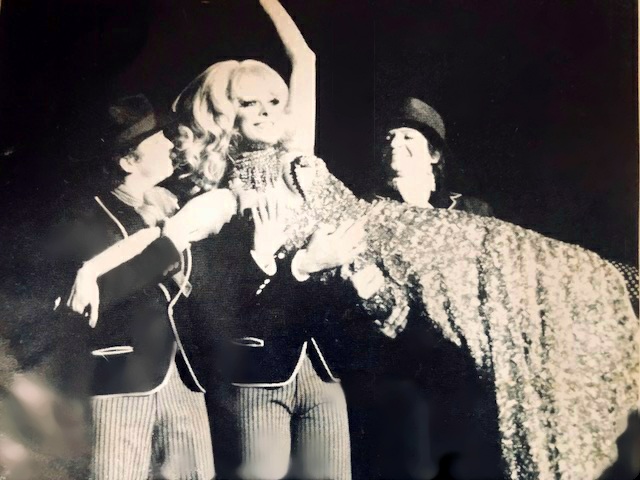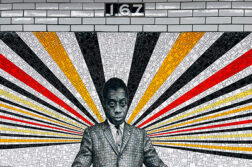
DRAG has gone mainstream in movies and television. Its supreme majesty RuPaul now owns entire evenings on the Logo television channel with her “drag races.”
But it wasn’t always this way. When I came out in the mid-1960s, gay people were closeted, and drag was an underground art. Bars in Atlanta were extremely diverse, from a large lesbian bar that actually served food in a converted warehouse, to the Prince Edward, which was upscale enough to require coat and tie, to the working class bars downtown, to Mrs. P’s, the only one that staged regular drag shows. Mrs. P’s, named after the owner’s mother, was an overcrowded first-floor hole in the wall that boasted a tiny stage.
Life at P’s was often anything but routine. One evening, as I approached the main entrance, I was nearly run down by a stampede of departing patrons. P’s had been invaded by a non-gay biker gang in full leather and chains. The owner simply called the police, who told the bikers, “They found their place; now you go find yours.” Calm returned to the scene. That was also the first serious indication to me that the police were well aware of our subculture, and tolerated us—either through bribes or, as I would rather believe, to the extent that we didn’t intrude into mainstream society.
It happened that the pair of guys I came out with at a mortician’s in Atlanta, while they did not do drag themselves, ran around with a group of the most famous (infamous?) drag queens. Since these queens chose to mother-hen me and in general to make my crazy life easier to accept (in general), there will always be a soft spot in my heart for people like them.
Foremost among them was Diamond Lil, with whom I occasionally danced and whom I saw out of drag only once in all those years, specifically entering a movie house as a very plain man. In drag, she was stunning, endlessly adorned with strands of fake jewelry. She was said to drive a Volkswagen bus, in the back of which were hung all of her outfits.
Then there was young Ernestine, who had just won the contest at Lafitte’s. Out of drag Ernestine was a beautiful young man: tall, with a slender but athletic body that the ancient Greeks would have died for. In drag, she was a head-turning young woman. Once, when the group was expecting to be shown a film of Ernestine onstage, it turned out the film had been double-exposed, superimposing Ernestine onto ghostly images of Jean Harlow. The two figures floated together and apart in a beautiful ballet. Although completely accidental, it was mesmerizing. In her heyday, Ernestine toured with the nationally famous Jewel Box Review, but apparently she subsequently fell on hard times as she was arrested one night, in drag, carrying a stolen chest of drawers across one of the smaller city parks. She was sentenced to two years at a minimum security facility, where she was given a cattle prod and put in charge of the livestock. Probably to her relief, they did allow her to wear makeup while herding her charges.
There were other queens, of course, since P’s had regular shows. One night in particular, an older, greatly overweight individual, apparently in an unfortunate attempt to recapture past glory, tried to strip, but she had chosen such a complex outfit that she quickly became hopelessly enmeshed in push up bras, frills, thongs, straps, and heaven knows what else. After a monumental attempt to extricate herself from her garments, she finally conceded defeat and had a good laugh along with everyone else.
One spring break, after I had become weary of the graduate school grind and of Atlanta in general, I decided to journey to Daytona, which had a very active gay scene. Friends supplied me with information on where to stay, and off I went in my ancient Volkswagen. The rental man I was referred to was bisexual; his wife was fully aware of his proclivities. His only request was that I not get the sheets dirty. The bar, it turned out, had drag shows and featured a very ample individual who styled herself as “Sophie Tucker” and belted out, not lip-synced, Ms. Tucker’s songs. I got to know her when she approached me to say that one of the regular patrons had expressed an interest in me. Did I reciprocate that interest? The lad in question was attractive and very personable but too young for me. With one glaring exception (a Dallas Teamster), I have always preferred men my own age or a bit older and more-or-less at my level of education. I remember telling the fellow that, although he was as cute as a speckled pup, the chemistry was just not there for me, and we went our separate ways. Later, as I was preparing to leave, a short, bald, very plain man said Hello to me. I was puzzled but replied in kind. Then he said, “You don’t know who I am, do you?” I admitted that was true. It was Sophie. As for me, I went home with the bartender, with whom I spent a very pleasant night and with whom I had a romantic stroll on the beach at dawn. But I was due back in Atlanta. Ships that pass in the night.
To my knowledge, none of the other cities in which I have lived—Roanoke, Buffalo, Plattsburgh (upstate New York), Cincinnati, Oklahoma City, and D.C. —have had drag bars. I am sure Florida has its share but only in the more youthful regions. Somehow I don’t envision one in Englewood or Venice. For my part, I’ve never been tempted to do drag, not even for Halloween, especially after a friend looked me up and down with a critical eye and declared that I would look like a spider in a dress.
 Stephen Fox is a retired professor now residing in Florida. While it took him a long time to accept being gay, he has now been in a relationship for 32 years and has been happily married for the last five.
Stephen Fox is a retired professor now residing in Florida. While it took him a long time to accept being gay, he has now been in a relationship for 32 years and has been happily married for the last five.





